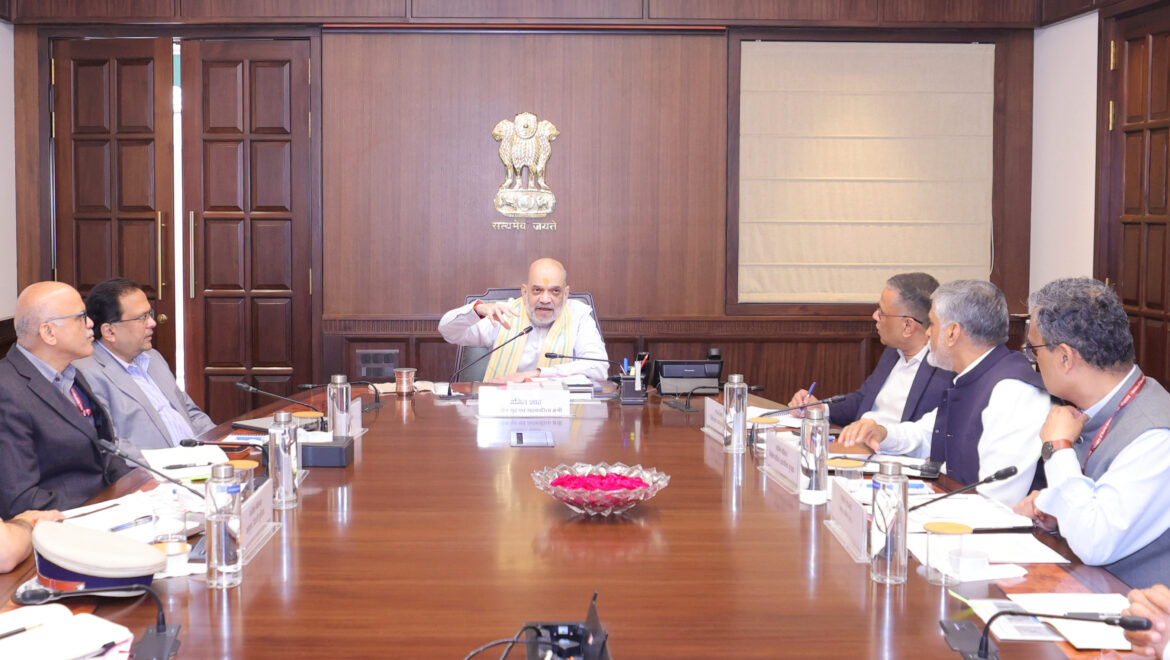New Delhi, November 11, 2025 — On a damp November evening, as commuters waited at a traffic light near the Lal Quila (Red Fort) metro gate, a slow-moving car suddenly detonated with a force that witnesses described as “different from a gas blast” — shattering glass, folding metal, igniting parked vehicles and sending a plume of black smoke over one of India’s oldest monuments.
At least eight people were killed and scores injured. Within hours, the city’s anti-terror apparatus was racing through a familiar choreography: forensic teams sealed the scene, CCTV footage was scrubbed for frames, mobile-phone pings were harvested, and a chain of leads pointed to a wider, multi-state investigation.
What began as a chaotic night in one of Delhi’s busiest corridors has, in less than 48 hours, opened into a sprawling probe threading through Kashmir and Haryana: arrests of medical professionals, massive seizures of explosive-making chemicals in Faridabad, and claims by police that posters and online messaging in Srinagar hinted at contacts with banned outfits.
Security officials say the blast could be the proximate act of a wider conspiracy — an effort that, if substantiated, would link an audacious daylight strike at the heart of the capital to a so-called “white-collar” module that has been under scrutiny for weeks. Hindustan Times+1
The scene and the first signals
Emergency responders arrived to scenes more horrific than first reports suggested: the car was essentially vaporized, nearby vehicles were aflame, and human remains and debris littered the intersection. The blast’s intensity — as captured on nearby CCTV and cellphone videos — has drawn the attention of bomb disposal squads and forensic explosives experts, who note two important early signals.
An Earthquake
The president of a local Business Association (Vyapar Sangh) described the explosion as first initially mistaken by businessmen in the area as an Earthquake. Most of them immediately shuttered their shops and fled to safety.
“First, the pattern of damage — a localized but extremely high-energy source at vehicle center, secondary fires, fragmentation consistent with metal casings — indicates an IED of considerable power, not a simple cylinder or CNG accident,” said a former explosives expert who recently worked with a national agency and reviewed publicly available footage.
“Second, the way vehicles nearby were set alight suggests incendiary components or shrapnel-bearing metal.” (Experts spoke on condition of anonymity because they are not authorised to comment on an ongoing investigation.)
Those early technical interpretations will now be subjected to laboratory confirmation: residue and soil samples from the blast crater, fragments collected by the bomb squad, and any metallurgical evidence sent for spectrographic analysis. If ammonium-nitrate-based compounds or military-grade explosives are detected, that will narrow the hunt considerably. The National Investigation Agency (NIA) and Delhi Police’s Special Cell — both with experience in counterterror forensics — have said they will lead or supervise these technical inquiries.
Tracing the vehicle, tracing the network
A crucial strand in any such probe is vehicle forensics: ownership history, recent transactions, GPS trackers, and telecom data linked to the vehicle’s occupants. Authorities have already traced the car’s registration and detained the registered owner for questioning; sources tell investigators they are also poring over toll- plaza and traffic-camera logs to reconstruct the route in the hours before the blast.
The aim is to determine whether the vehicle was driven into the traffic stream as a suicide bomb, parked and remotely detonated, or booby-trapped in a way designed to simulate an accident.
But investigators are not looking at the car in isolation. In the same 72-hour sweep that followed the explosion, law enforcement agencies executed coordinated operations across several jurisdictions — most notably Faridabad in the Delhi-NCR belt — recovering what officials described as an unprecedented cache of explosive-making materials and bomb components.
Reports from multiple outlets indicate that police seized thousands of kilograms of chemicals and materials that could be used to fabricate large numbers of improvised explosive devices. Several people, including medical professionals, have been detained in connection with those seizures. Authorities have described the uncovered activity as a “white-collar” terror ecosystem: professionals and students allegedly radicalized and allegedly in touch with handlers outside India. And this was reported from Srinagar in Kashmir, a month ago.
Two lines of inquiry have now emerged: one, whether the Red Fort blast was the work of an isolated cell using an opportunistic vehicle-borne device; and two, whether it is the first visible strike in a plot conceived and supplied by a larger network that had been stockpiling material in and around the capital. That second possibility is underscored by the timing of the Faridabad seizures and by earlier investigative leads in Kashmir that reportedly prompted those raids.
Police sources say posters and messages spotted in Srinagar in recent weeks — referring to the banned Jaish-e-Mohammed — triggered inquiries that unveiled a chain of contacts extending into the NCR. Authorities are cautious, however, and stress that links between seizures and the blast remain to be fully established.
The JeM question and the shadow of Srinagar
Publicly, officials have stopped short of naming a perpetrator for the blast; privately, several sources say attention has turned toward groups long active along the India-Pakistan line, including Jaish-e-Mohammed (JeM). Indian police statements and regional reporting have repeatedly cited Jaish imagery and slogans as part of the tilt of the investigation into the recent network busts — noting that the posters in Srinagar prefixed the Faridabad arrests.
Yet intelligence agencies emphasize that symbolic support (posters, slogans) does not automatically equate to operational control. What matters is the chain: who supplied the explosives, who provided technical know-how, who facilitated logistics, and whether handlers abroad were directing targets and timings.
Intelligence officials also point to a worrying trend identified in the recent state-led operations: the radicalization of credentialed professionals — university students, medical practitioners — who may have access to laboratories, chemicals, vehicles and cover identities that make detection harder.
“When people with legitimate professional lives are co-opted, the network’s ability to operate in plain sight increases dramatically,” a senior security analyst said. That is why investigators are treating the possibility of a transnational supply chain seriously; documents and digital trails from the recent seizures are being cross-checked with intercepts and financial-transaction intelligence.
Forensics, EOD and the slow science of proof
Forensic confirmation is a deliberately slow science. Explosives labs will run chromatographic and mass-spectrometric tests on residues; EOD technicians will map blast signatures; structural engineers will model blast propagation. These techniques not only identify the explosive but can sometimes reveal the trigger mechanism: a timer, a mobile phone acting as a detonator, or a pressure/impact fuse consistent with a suicide device.
If investigators find traces of military-grade explosives or a specific initiator module, they can sometimes trace components to a supplier channel — a key turn in moving from scene-level forensics to network attribution.
CCTV and phone records will be paired with forensic timelines to attempt a minute-by-minute reconstruction. In past high-profile probes, such as the 2008 Delhi serial blasts and the 2006 Mumbai train bombings, that pairing has been central to identifying couriers and safe houses; the same methodology is now being applied here. But attribution — saying with confidence which group ordered, planned, financed or executed an attack — requires a higher evidentiary bar: intercepted directives, admissions in custody, or material links (like recovered documents or communication with known handlers).
Until then, investigators and policy makers must balance public urgency with the patience required for airtight legal cases.
The international angle
Because investigators say the Faridabad materials appear to have transnational linkages — and because several arrested suspects are reported to have contacts in Kashmir and beyond — there is diplomatic sensitivity to the probe. New Delhi’s security establishment will be looking for corroboration from international intelligence partners about money flows, messaging app networks and supply lines for certain explosive precursors.
For now, the government’s public posture has been to warn against speculation and to promise a fast but methodical inquiry; privately, officials have warned of heightened threats to “soft targets” and infrastructure in the weeks ahead.
What the Red Fort blast tells us — and what it doesn’t
There are three immediate takeaways from the available evidence and reporting: one, the blast was a high-intensity event that required materials and expertise beyond an improvised amateur; two, the timing and location — a busy urban junction near an iconic national monument — suggest an intent to maximize casualties and symbolic effect; and three, the recent seizures in Faridabad and searches linked to Srinagar provide plausible leads to a broader module that may have been preparing multiple devices. But none of these points, on their own, closes the loop to a verdict of responsibility. That requires forensic ties to people and channels that can be produced in court.
A short history: major urban bombings in the last 20 years
To place the Red Fort blast in context, here is a concise list of major urban explosions and terror attacks in India over the past two decades (non-exhaustive):
- 2006 — Mumbai train blasts (July 11): Seven blasts on suburban trains killed 189 and injured over 800 (Mumbai).
- 2008 — Delhi serial bombings (Sept 13): Multiple blasts in Karol Bagh, Connaught Place and Greater Kailash killed dozens and injured many.
- 2008 — Mumbai attacks (Nov 26–29): Coordinated shootings and bombings at hotels and the CST station killed over 160.
- 2011 — Mumbai blasts (July 13): Explosions in Dadar, Zaveri Bazaar and Opera House killed and injured dozens.
- 2013 — Hyderabad twin blasts (Feb 21): Two blasts in Dilsukhnagar killed 18 and injured 131.
- 2013 — Bodhgaya blasts (July 7): Blasts at a major Buddhist pilgrimage site injured monks and pilgrims.
- 2010 — Pune German Bakery blast (Feb 13): A bomb in a popular café killed 17 and injured many.
- 2024 — Rameshwaram Cafe blast (Bengaluru) (Mar 1): An IED detonated in a city café, injuring civilians.
- 2025 — (This) Red Fort car blast, New Delhi (Nov 10): A high-intensity explosion in a vehicle outside Lal Quila metro gate — at least eight dead.
The politics of response
Politically, the blast lands at a fraught moment: it has already prompted a nationwide security alert, sharp rhetoric from elected leaders, and political theatre in state capitals. While governments must demonstrate vigilance, security officials caution against premature attributions that could complicate cross-border diplomacy or criminal prosecutions. The legal architecture for terrorism cases in India — including the Unlawful Activities (Prevention) Act — provides for strong investigative powers but also requires careful case building to withstand judicial scrutiny.
What to watch for next
Expect investigators to publish forensic details in stages: preliminary lab reports on explosive residues, analysis of the detonation mechanism, and then — if links are found — a narrative tying seized materials and suspects to the device used in Delhi. Courts will likely see remand petitions, charge sheets, and appeals to intercept evidence. For the public, the months ahead will reveal whether this act was an isolated, opportunistic strike or the first visible assault from a network whose ambitions were concealed in plain sight.
For now, the Red Fort blast is a brutal reminder: urban terror remains adaptive, and the lines between ideology, logistics and professional cover are blurring. The forensic scientists at work in the charred intersection will take time to convert ash and metal into proof. When they do, the nation will demand nothing less than a thorough accounting — and, if evidence points to handlers outside its borders, a sustained, coordinated response to choke the pipelines that make such carnage possible.
Disclaimer: The opinions and views expressed in this article/column are those of the author(s) and do not necessarily reflect the views or positions of South Asian Herald.






